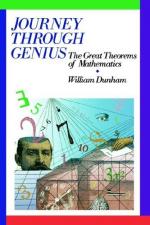
|
| Name: _________________________ | Period: ___________________ |
This quiz consists of 5 multiple choice and 5 short answer questions through Cardano and the Solution of the Cubic.
Multiple Choice Questions
1. Which words best describe how solid proofs were developed in Elements?
(a) Programmed order.
(b) Inverted scaffold.
(c) Axiomatic framework.
(d) Simple arguments.
2. Which is one of the common notions presented in Elements?
(a) "Points with equal values can be connected with a line of equal value."
(b) "Things which are equal to the same thing are also equal to each other."
(c) "The inverse of a line makes a circle."
(d) "Things with are equal have an inverse that is equal."
3. "Straight lines in the same plane that will never meet if extended forever" is a definition of what?
(a) Parallel lines.
(b) Circle.
(c) 180 degree angle.
(d) Intersection.
4. Which of the following is true in modern math about twin primes?
(a) Their sum is always another prime number.
(b) We don't know if they are finite or infinite.
(c) They are infinite.
(d) They are not considered whole numbers.
5. Which of the following becomes an important definition in mathematics that was first presented in Elements?
(a) 180 degree angle.
(b) Parallel line.
(c) Circle.
(d) Intersection.
Short Answer Questions
1. What instruments did the Greeks use to square a shape?
2. Who's method did Tartaglia's challenger use in the contest to solve cubic equations?
3. Who was the first of ancient philosophers to consider why geometric properties existed?
4. What was the same about Apollonius and Erosthanes?
5. Which of the following was NOT defined by Euclid?
|
This section contains 271 words (approx. 1 page at 300 words per page) |

|




